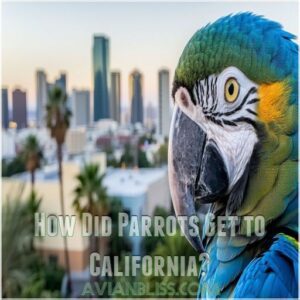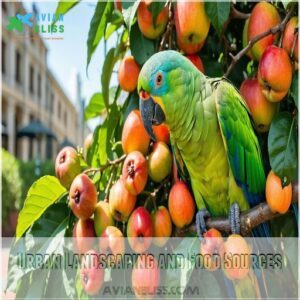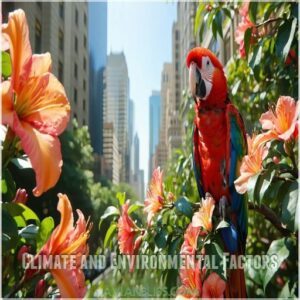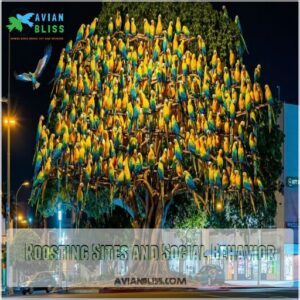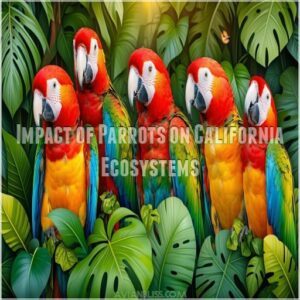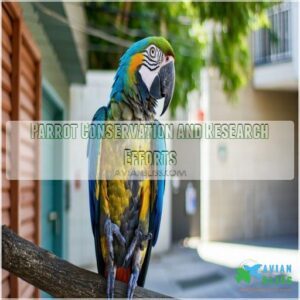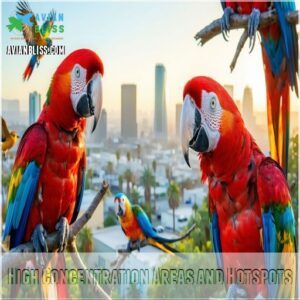This site is supported by our readers. We may earn a commission, at no cost to you, if you purchase through links.
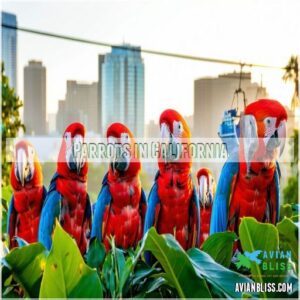
These feathered adventurers, primarily escapees from the pet trade, have transformed city streets into their personal playgrounds.
Southern California’s warm climate and lush landscapes provide the perfect backdrop for these vibrant birds.
From Pasadena to Long Beach, you’ll spot these colorful parakeets roosting in exotic trees and bustling neighborhoods.
They’re not just pretty faces—these parrots play essential roles in seed dispersal and local ecosystems.
While they might ruffle a few feathers with their noise, they’ve become an unexpected part of California’s wild urban tapestry.
Want to know their secret survival strategies?
Table Of Contents
- Key Takeaways
- Parrots in California
- How Did Parrots Get to California?
- Parrot Habitats and Adaptation
- Impact of Parrots on California Ecosystems
- Parrot Conservation and Research Efforts
- Where to Find Parrots in California
- Frequently Asked Questions (FAQs)
- Do parrots breed in Southern California?
- How many species of parrots are there in California?
- Are parrots a common sight in Los Angeles County?
- How many species of parrots are there in Los Angeles?
- Did parrots make it to Los Angeles?
- Should parrots be kept in California?
- Are there parrots in California?
- How did parrots get to California?
- Why does San Diego have wild parrots?
- Why are there so many wild parrots in Los Angeles?
- Conclusion
Key Takeaways
- You’ll discover that California is now home to 13 wild parrot species, most of which descended from escaped pets and unintentional releases in urban landscapes since the 1970s.
- You’ll find these exotic birds have masterfully adapted to Southern California’s climate, transforming city parks, gardens, and trees into thriving habitats that support their survival and reproduction.
- You’ll learn that these feral parrots aren’t just colorful visitors, but active participants in urban ecosystems, playing roles in seed dispersal, pollination, and challenging traditional conservation expectations.
- You’ll realize that these wild parrots represent a remarkable story of urban wildlife adaptation, turning accidental migrations and pet trade mishaps into a vibrant, unexpected ecological phenomenon across California’s cities.
Parrots in California
You’ll be amazed to discover California’s wild parrot populations, which have transformed urban landscapes into vibrant avian habitats since the 1960s.
These colorful, intelligent birds, primarily escaped pets and their descendants, now thrive in Southern California’s cities.
Creating an unexpected and fascinating ecological phenomenon.
History of Feral Parrot Populations
When pet owners in the 1970s accidentally—or intentionally—released exotic parrots, California’s urban landscape transformed.
These vibrant escapees found unexpected freedom, turning city skies into their new playground.
Illegal imports and accidental releases fueled a colorful revolution, with feral parakeets and parrots establishing remarkable populations across Southern California’s welcoming urban ecosystem.
Origins and Species Found in California
Soaring through California’s urban landscapes, exotic parrots have turned city streets into their personal aviaries. These colorful invaders represent a fascinating blend of accidental migration and intentional release. California’s parrot scene is unique for several reasons.
- 13 non-native parrot species call California home
- Red-masked Parakeets lead the urban feathered revolution
- Escaped pets fuel most parrot population growth
Southern California provides the perfect tropical playground.
Current Population and Distribution
The urban landscape of California has become a surprising sanctuary for wild parrots, with population estimates revealing a remarkable story of adaptation.
From Pasadena to San Diego, these feral flocks have mapped out impressive territories across 35 cities.
Southern California wild parrots now dominate urban ecosystems, showcasing an extraordinary range expansion that challenges traditional conservation expectations.
How Did Parrots Get to California?
Ever wondered how colorful parrots found their way into California’s urban landscapes?
These feathered adventurers mostly arrived through the pet trade,
with many escaping or being intentionally released by owners who could no longer care for them.
The Pet Trade and Release of Captive Birds
Exotic pet markets turned California’s urban landscapes into unexpected parrot havens.
Captive breeding fueled a complex web of releases, where well-intentioned owners unknowingly transformed city ecosystems.
The illegal trade of colorful companions sparked ethical dilemmas, pushing these intelligent birds from private cages into vibrant, nonnative tree-lined streets, creating thriving wild populations that challenge traditional conservation narratives. Exotic pet markets and illegal trade are the root causes.
Accidental Releases and Escapes
Ever wonder how California’s wild parrots became urban adventurers?
Accidental releases tell a fascinating story of feathered freedom.
It’s suspected that cargo mishaps and unintentional escapes transformed captive birds into unexpected residents.
These winged wanderers slip through gaps in crates, aviaries, and shipping containers, finding unexpected sanctuary in California’s welcoming urban landscapes – turning accidents into amazing migrations.
Smuggling and Illegal Importation
By the late 1970s, illegal wildlife trade had transformed California’s parrot landscape.
Smuggling routes cutting through Mexico brought endangered species into the state, bypassing strict regulations.
Black market demand drove a lucrative underground network of parrot importation, with penalties and fines doing little to deter determined traders.
Exotic parrot breeders and illegal importers exploited complex enforcement challenges, introducing rare species like red-crowned and lilac-crowned parrots into urban ecosystems through clandestine channels.
Parrot Habitats and Adaptation
You’ll be amazed at how California’s urban landscapes have become the perfect playground for wild parrots, transforming city streets into exotic bird havens.
Their remarkable adaptability lets them thrive in non-native environments, turning exotic trees, artificial irrigation, and abundant food sources into their own urban oasis.
Urban Landscaping and Food Sources
Imagine a feast for California’s wild parrots, where urban landscapes transform into lush buffets of exotic delights! These colorful invaders navigate city, turning landscaped gardens into personal dining rooms.
Urban vegetation provides a critical lifeline for these feathered refugees, offering year-round sustenance through carefully curated plant selections.
- Exotic trees create gourmet foraging opportunities
- Landscaping shapes wild parrot survival strategies
- Urban oases support complex feeding ecosystems
California’s intentional plant choices inadvertently roll out the red carpet for these remarkable urban survivors, providing them year-round sustenance and making them urban survivors.
Climate and Environmental Factors
Southern California’s urban landscape transforms into a haven for parrots, where climate adaptation becomes their superpower. Non-native plants and artificial irrigation create a lush environment that supports these feathered survivors.
They’re masters of reinvention, shifting ecological niches with remarkable ease. Like their counterparts in Florida, where wild populations thrive, California’s parrots have developed unique survival strategies.
They’re not just surviving amid California’s changing conditions; they’re conquering urban ecosystems one tree at a time. This urban adaptation is a testament to their remarkable resilience.
| Factor | Adaptation | Impact |
|---|---|---|
| Climate | Resilience | Survival |
| Landscape | Flexibility | Expansion |
| Resources | Innovation | Persistence |
| Temperature | Adjustment | Endurance |
| Environment | Transformation | Success |
The success of these parrots highlights their ability to thrive.
Roosting Sites and Social Behavior
Wild parrots transform urban trees into vibrant social networks across California.
Their preferred roosts become bustling communication hubs.
These Southern California wild parrots demonstrate remarkable social intelligence through their interconnected urban communities.
They share:
- Complex territorial signals
- Intricate mating rituals
- Sophisticated flock dynamics
Impact of Parrots on California Ecosystems
Ever wondered how colorful parrots are reshaping California’s urban ecosystems?
creating both challenges and unexpected opportunities for local wildlife?
You’ll discover how these exotic birds are competing with native species, spreading seeds, and turning city landscapes into surprising ecological experiments.
that blend adaptation, conservation, and urban wildlife management.
Effects on Native Bird Populations
As urban landscapes become battlegrounds, California parrots stake their claim against native bird populations.
Mitred and nanday parakeets muscle in on prime territories, creating complex ecological chess matches. Their competitive edge threatens local species through resource competition and niche overlap.
Red-crowned parrots emerge as particularly aggressive players, disrupting delicate ecosystem balances.
Native birds find themselves squeezed out of traditional habitats, facing unprecedented challenges from these feathered invaders who’ve turned urban environments into their personal playgrounds.
| Species | Competition | Impact |
|---|---|---|
| Nanday Parakeet | High | Displacement |
| Mitred Parakeet | Medium | Predation |
| Red-crowned Parrot | Variable | Nesting Sites |
Noise Pollution and Nuisance Complaints
When native birds bow out, raucous parrot populations surge, turning urban soundscapes into wild symphonies.
Southern California residents face mounting noise challenges from these feathered disruptors.
Consider these parrot noise mitigation strategies:
- Soundproofing windows
- Strategic landscaping buffers
- Community noise ordinances
- Wildlife management consultations
- Adaptive urban planning
Feral parrots: nature’s unfiltered, ear-splitting urban soundtrack.
Potential for Conservation and Ecological Value
Parrots in California aren’t just colorful invaders—they wield serious conservation potential.
Their ecological roles like pollination and seed dispersal impact biodiversity while sparking debates about invasive species.
Smart management strategies can balance their quirks with benefits.
Research into California wildlife shows urban parrot populations playing a surprising part in wildlife conservation.
Check out this snapshot of their impact:
| Role | Benefit | Challenge |
|---|---|---|
| Pollination | Boosts biodiversity | Competes with bees |
| Seed Dispersal | Restores habitats | Disrupts natives |
| Predator Avoidance | Attracts viewers | Spreads diseases |
| Keystones | Supports ecosystems | Requires balance |
| Urban Adaptation | Educates communities | Noise complaints |
Parrot Conservation and Research Efforts
You’ll be fascinated by the groundbreaking research uncovering how wild parrots are adapting to California’s urban landscapes.
By following the Free Flying Los Angeles Parrot Project, you’ll discover critical insights into these remarkable birds’ ecological roles and conservation challenges.
The Free Flying Los Angeles Parrot Project
Some scientists at Occidental College have launched the Free Flying Los Angeles Parrot Project, diving deep into urban ecology.
Their mission? Unraveling the mysteries of wild parrots in Southern California.
By tracking these feathered urban dwellers around Temple City and Rosemead Boulevard, researchers aim to secure conservation efforts and understand hybridization risks facing these remarkable feral parakeets.
Monitoring and Studying Parrot Behavior
Urban wildlife detective? You’ll need these pro tips for studying wild parrot behavior:
- Deploy non-invasive tracking technologies to map vocalizations and social structures
- Use advanced data loggers to monitor breeding success without disturbing flocks
- Analyze dietary patterns revealing Southern California wild parrots’ incredible adaptation strategies
Capture their world through scientific precision and quiet observation.
Hybridization and Conservation Implications
California’s parrot population is a genetic melting pot, where species intermix like colors in a wild paint splash. This hybridization brings both promise and peril for conservation efforts.
Researchers track these feathered mixologists, watching how different species interact and potentially breed. Egg turning behavior, such as diurnal egg turning rates, can also inform conservation strategies.
| Trait | Impact | Significance |
|---|---|---|
| Genetic Diversity | Adaptation | Species Survival |
| Breeding Patterns | Mixing | Ecological Shift |
| Population Health | Complexity | Conservation Challenge |
| Behavioral Changes | Unpredictability | Research Focus |
| Survival Strategies | Resilience | Evolutionary Potential |
These dynamic interactions reshape our understanding of wild parrot populations in California’s urban landscapes.
Where to Find Parrots in California
You’ll be amazed to discover wild parrots thriving in California’s urban landscapes, from Los Angeles to San Francisco.
Get ready to explore their colorful world.
Check out local parks, tree-lined streets, and well-established neighborhoods where these exotic birds have made themselves right at home.
High Concentration Areas and Hotspots
You won’t believe the wild parrot hotspots scattered across Southern California’s urban landscape! These feathered adventurers have claimed their territory in vibrant city clusters.
Now you can even join California parrot tours to get a closer look!
- Pasadena’s green-winged residents rule neighborhood trees
- Redlands hosts spectacular flock gatherings
- Riverside provides perfect roosting locations
- Long Beach echoes with exotic bird chatter
- Temple City boasts massive wild parrot populations
Grab your binoculars and explore these unexpected avian metropolises where wild parrots thrive! This is a great opportunity to see Southern California’s amazing parrots.
Best Viewing Times and Locations
Sunset transforms Southern California’s urban landscapes into a parrot paradise, offering wildlife enthusiasts prime wild parrot sightings.
Winter months reveal spectacular seasonal variations in flocking patterns, with enthusiastic birdwatchers converging on hotspots like Pasadena, Arcadia, and Riverside.
Similar to the red-crowned parrots in Texas, California’s parrot populations also face conservation threats due to habitat loss and other environmental factors.
Prime viewing hours cluster around sunset, when California’s feathered urban dwellers gather in magnificent aerial displays.
| Location | Best Time | Favorite Food | Roosting |
|---|---|---|---|
| Pasadena | Sunset, Winter | Canary Island Date Palms | South Pasadena |
| Arcadia | Sunset, Winter | Canary Island Date Palms | Arcadia Arboretum |
| Riverside | Sunset, Winter | Canary Island Date Palms | Mount Rubidoux |
| San Bernardino | Sunset, Winter | Canary Island Date Palms | San Bernardino National Forest |
Grab your binoculars and camera – wild parrot sightings promise an unforgettable wildlife spectacle!
Tips for Spotting and Observing Parrots
Any keen birder can master wild parrot sightings in California with these strategic tips.
Here’s your game plan for epic california parrot sightings:
- Scout exotic urban parks near Los Angeles
- Arrive during dawn or dusk hours
- Pack high-quality binoculars for crisp views
- Move slowly and quietly to avoid startling these intelligent wild parrots
Patience transforms casual observers into seasoned parrot spotters.
Frequently Asked Questions (FAQs)
Do parrots breed in Southern California?
When urban wings unfurl, California’s parrots find their nesting niches.
You’ll discover these exotic birds breeding prolifically in Southern California’s cities.
Southern California’s cities are transformed by their vibrant populations and adaptive urban survival strategies.
How many species of parrots are there in California?
You’ll find thirteen different parrot species dancing through California’s urban landscapes, from the Red-masked Parakeet to the rare Lilac-crowned Amazon, each telling a vibrant story of adaptation and unexpected wildlife.
Are parrots a common sight in Los Angeles County?
Ever wondered if Los Angeles skies are filled with colorful parrots?
They’re surprisingly common!
Red-crowned and Nanday Parakeets have made urban landscapes their home, thriving in Southern California’s exotic gardens and creating vibrant, unexpected wildlife scenes.
How many species of parrots are there in Los Angeles?
Discover seven vibrant parrot species calling Los Angeles home, from the Red-crowned Amazon to the Nanday Parakeet.
These urban dwellers, mostly escaped pets, thrive in the city’s exotic landscape and mild climate.
Did parrots make it to Los Angeles?
Ironically, you’ve stumbled into a wild urban jungle.
Los Angeles streets buzz with exotic parrot flocks.
These parrots aren’t just survivors—they’re thriving! They are descendants of escaped pets who’ve turned the city into their vibrant, feathered playground.
Should parrots be kept in California?
You shouldn’t keep parrots in California unless you’re a responsible, knowledgeable owner.
Wild populations thrive, but pet ownership requires specialized care, understanding of their complex needs, and commitment to preventing accidental releases.
Are there parrots in California?
Like wild feathered rebels crashing California’s party, over a dozen exotic parrot species now call the state home.
You’ll spot these colorful immigrants roosting in urban landscapes, descendants of escaped pets thriving in mild, welcoming environments.
How did parrots get to California?
Escaped pets and intentional releases brought parrots to California. The mild climate, exotic vegetation, and urban landscapes created perfect conditions for these colorful birds to thrive and multiply.
Why does San Diego have wild parrots?
San Diego’s wild parrots thrive due to the city’s mild climate.
Abundant exotic plants provide food sources.
Urban landscapes offer perfect nesting spots for these adaptable, non-native bird immigrants.
Why are there so many wild parrots in Los Angeles?
You’ll find wild parrots thriving in Los Angeles.
Due to perfect urban conditions: exotic landscaping, mild climate, abundant food sources, and a history of pet releases.
These create ideal habitats for these adaptable, intelligent birds.
Conclusion
Surprisingly, California’s urban parrots aren’t just colorful interlopers—they’re ecosystem pioneers.
You’ll find these adaptable birds transforming city landscapes, challenging our understanding of wildlife adaptation.
Whether you’re a bird enthusiast or casual observer, the parrots in California represent a fascinating urban wildlife phenomenon.
Their resilience and unexpected presence remind us that nature finds a way, even in the most unexpected urban jungles. Keep your eyes peeled for these feathered urban adventurers!
- https://www.imdb.com/title/tt0424565/
- https://laist.com/news/pasadenas-parrots-are-annoying-af-but-may-save-their-species-from-extinction
- https://globalbirdinginitiative.org/bird-identification/species-by-location/california-us/parrots-in-california/
- https://petshun.com/article/where-do-southern-california-wild-parrots-come-from
- https://www.latimes.com/environment/story/2024-03-03/feral-mexican-parrots-thrive-on-exotic-l-a-landscaping

